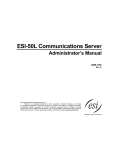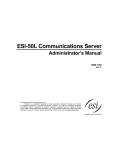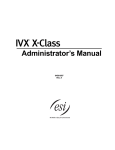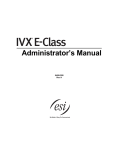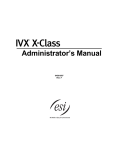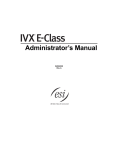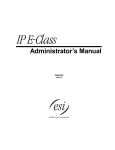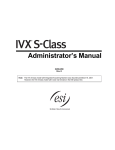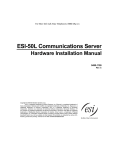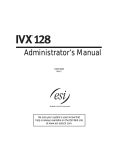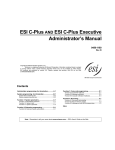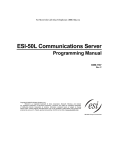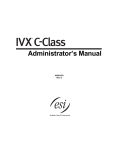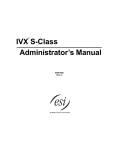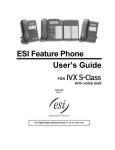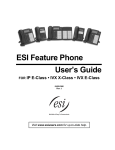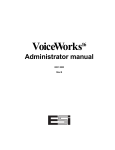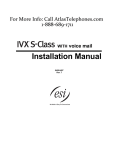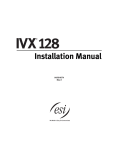Download ESI 24-Key Digital Feature Phone User`s guide
Transcript
ESI Communications Servers ESI-1000 • ESI-600 • ESI-200 • ESI-100 • ESI-50 Administrator’s Manual 0450-1048 Rev. F Copyright © 2008 ESI (Estech Systems, Inc.). IVX is a registered trademark of Estech Systems, Inc. Ethernet is a registered trademark of Xerox Corporation. Microsoft, Windows, and Outlook are registered trademarks of Microsoft Corporation. Panasonic and DBS are registered trademarks of Matsushita Electric Corporation of America. Information contained herein is subject to change without notice. Certain features described herein may not be available at initial release. ESI products are protected by various U.S. Patents, granted and pending. Visit ESI on the Web at www.esi-estech.com. Contents Administrator programming: An introduction ...............A.1 Function 6: Recording..........................................................F.1 System capacities .................................................................B.1 Function 61: Re-record system and branch prompts.............. F.1 Function 62: Record directory names..................................... F.2 Function 63: Message-on-hold (MOH) programming.............. F.3 Function 1: System parameters.........................................C.1 Function 13: Administrator password....................................... C.1 Function 14: System clock ..................................................... C.1 Function 16: System feature parameters ............................... C.3 Function 17: System speed-dial............................................. C.4 Function 3: Extension programming................................D.1 Function 30: Station move ..................................................... D.1 Function 32: Extension feature authorization ......................... D.2 Function 33: Department programming.................................. D.6 Function 37: RFID programming............................................ D.7 Function 5: Voice mail programming...............................E.1 Function 7: Reports..............................................................G.1 Report printing....................................................................... G.1 Reporting functions ............................................................... G.1 Feature description: SMDR ................................................ H.1 Standard tabular SMDR format ..............................................H.1 CSV SMDR format.................................................................H.2 SMDR format when using account codes...............................H.3 Reporting conventions and rules (standard and CSV formats)H.4 Extended SMDR format .........................................................H.5 Index Function 53: Guest/info mailboxes......................................... E.1 Function 54: Group mailboxes and the broadcast mailbox..... E.2 Function 55: Message notification.......................................... E.3 Function 56: Cascade notification mailboxes ......................... E.4 Function 57: Q & A mailboxes................................................ E.5 Note: Remember to tell your users about www.esiusers.com — ESI’s User’s Guide on the Web. ESI Communications Servers Administrator’s Manual Administrator progrmming: An introduction Administrator programming: An introduction You can program an ESI Communications Server (ESI-1000, ESI-600, ESI-200, ESI-100, or ESI-50) locally or remotely from a 48-Key or 24-Key Feature Phone while the system is operating. You also can program using ESI System Administrator, a Windows-based software application your ESI Reseller can provide. Read the User’s Guide first. The programming of features requires a clear understanding of user interface and application. Administrator’s duties The System Administrator can perform the following tasks: • • • • • Administering station assignments Managing station feature authorization Maintaining the employee directory (if it’s used) Re-recording system prompts Administering manual change of day/night mode (if required) User assistance Each ESI Communications Server’s Verbal User Guide includes all of the information printed in the User’s Guide (except for special features). Additionally, the ESI system users’ Web site, www.esiusers.com, includes all the information in the User’s Guide, and more. Note: Except where noted, the remainder of this “General description” chapter describes only features, rather than any system capacities. For system-specific capacity specifications — e.g., CO lines, ports, message storage, etc. — see “System capacities” (page B.1). Telephone system features • • • Impressive expansion capability — Each system accepts one or more Expansion Cabinets to maximize its potential call-handling. 1 T1 and PRI support — Can connect to higher-bandwidth lines, which more and more offices use. ESI Feature Phones — Compact and stylish, yet rugged, each ESI Feature Phone includes a high-quality speakerphone, large and informative multi-functional display and a specially designed key layout with several dedicated keys to minimize or eliminate the need to memorize codes. ESI’s 48-Key Feature Phone comes in two versions, digital and IP. Each 48-Key Feature Phone model includes an integrated headset jack and is available with backlit display. Other ESI phone models include the 24-Key Feature Phone (available with 2 backlit display), 12-Key Feature Phone, and Cordless Handsets. Note: The 12-Key Feature Phone has the same stylish, rugged ESI Feature Phone design and offers the most basic phone functions. It is intended for use in areas such as lobbies, cashier stations, warehouses and employee lunchrooms, where only minimal phone system features are needed. • • • • 1 2 3 Extensive help — ESI’s Verbal User Guide™ uses spoken and displayed help prompts to help everyone from the Installer through the Administrator down to the least experienced end user. Easily accessible with one press of either the HELP key on the 48-Key Feature Phone or the PROG/HELP combo key on the 24-Key Feature Phone. One can also visit www.esiusers.com for comprehensive help. 3 Enhanced Caller ID — Allows one-touch automatic message return. An ESI Communications Server passes Caller ID data to both digital and analog ports. Live call recording — Can record any conversation or personal memo, with moving or copying of any recording to another user’s voice mailbox (see “Voice mail features,” below). Call waiting — Includes helpful display, showing both calls’ Caller ID information, and easy one-key toggling between calls. The ESI-50 supports only PRI (not T1). See also the ESI Communications Servers Hardware Installation Manual (ESI document #0450-1049). This and all other references to Caller ID service within this manual assume the end-user organization subscribes to Caller ID service from its telephone service provider. A.1 ESI Communications Servers Administrator’s Manual • • • • • Administrator progrmming: An introduction Conference calling — Includes up to 64 dynamic conference ports; a single conference may contain up to 1 16 members. Conference bridges are dynamic, so possible conference sizes include: 21 three-member; 16 four-member; 10 six-party; and various combinations in-between. Analog phones on the system also may originate conferences. Esi-Dex™ speed-dialing — Calls any number using four separate lists (personal, station, system and — when Esi-Link is in use — cabinet location); uses Caller ID information or direct keypad entries. Dedicated overhead paging interface — Allows for external paging through overhead speakers or multizone paging units (amplification required) and separate, vendor-supplied zone page adapters. Intelligent Call Forwarding™ — Lets users of compatible PRI-equipped ESI systems view the original Caller ID data of a call forwarded to an off-premises phone. 2 911 alert — Provides immediate line access if any station dials 9 1 1 to report an emergency; sends a message via the serial port indicating the start date, time, station number and end-time of the 911; also sounds an audible warning at the operator station and displays, for example: 911 CALL FROM X102 JOHN JAMES 3 Important: Remember to advise your customers not to make 911 calls using a remote IP phone. Because such a phone isn't connected directly to the local telephone network, it’s necessary instead to use a regular phone connected locally, not the remote IP phone, to make 911 or other emergency calls. (For more information, see the documentation included with the remote IP phone.) • • Shared-office tenanting — Tenant service allows multiple business entities to share a telephone system while maintaining separation of various facilities and features. For more details, consult your ESI Reseller. Support for these options: – Esi-Link — Allows a multi-site enterprise to network any combination of dozens of compatible ESI phone systems across an IP-based network. Note: The ESI-50 can be in an Esi-Link network with only other ESI Communications Servers running certain system software. If necessary, consult your ESI Reseller for assistance. – VIP™ — Provides a value-added interface to an ESI Communications Server. Delivers call control and ® ® unified messaging to Microsoft Outlook 2000/2002/2003/2007. – ESI Presence Management — Provides integrated building entry control, access control, status indication, personal call routing, and (optionally) time and attendance management. – ESI Cellular Management — Part of ESI Bluetooth Voice Integration, ESI Cellular Management provides unique hardware and features to bridge the gap between cellular handsets and ESI’s line of Feature Phones. Voice mail features • • • • • • • • • • 1 2 3 Built-in voice mail ports — These are in addition to the call-processing ports; thus, you may build the system to its maximum for call-handling without having to balance voice mail needs versus call-handling needs. For specific voice storage capacities on a system-by-system basis, see “System capacities” (page B.1). Highest-grade voice quality (64-kilobit/second sampling) for voice mail and other storage of voice messages. Message-on-hold (MOH) recordings — Among these are three prerecorded tracks; also supports live entry. If your Installer has enabled tenant service, each tenant has its own MOH source. Off-premises message delivery — Automatically delivers voice messages to designated phone number, such as a cell phone, when one is out of the office. Urgent messages — Can deliver higher-priority messages first. Several different mailbox types, including group, broadcast, informational, cascade notification and Q & A. Message Recycle Bin (undelete) — Remembers, and can restore, each mailbox’s 10 most recently deleted messages. ™ Quick Groups — Makes it easy to leave voice mail messages for several users. ™ Quick Move — Records a conversation into another user’s mailbox. ™ Virtual Mailbox Key allows easy monitoring of a second mailbox. See “System capacities” (page B.1). An ESI Remote IP Cordless Handset sends 911 calls via the local analog CO line attached to the Cordless Handset’s base station. The 911 alert information isn’t available at the operator station or via serial port. A remotely installed IP Feature Phone II, a Remote IP Cordless Handset, or a remote installation of VIP Softphone. A.2 ESI Communications Servers Administrator’s Manual Administrator progrmming: An introduction Auto attendant features • • Six levels, 100 branches — Allow you and your customer to set up a more caller-friendly answering environment, including a company directory. Virtually unlimited call routing — Includes off-premises transfer, pager notification, more. ACD features • • • Routes calls within designated departments for quickest possible call answering. Uses three-line Digital Feature Phone display to provide up-to-the-second information on queues, wait times, delay announcement, priority queueing, and overflow routing. Optional VIP ACD Supervisor and VIP ACD Agent enhance ACD usage; VIP ACD Supervisor offers highly 1 useful reports and also gives ability to customize reports. Feature Phone overlays Each Feature Phone comes with one overlay for the programmable feature keys. To order additional overlays, ™ visit the DESI Web site, www.desi.com. While there, you may also want to download the free Windows-based software, DESI Lite, which allows you to print on the overlays. For assistance with DESI products, contact DESI (the DESI Web site contains contact information). Tip: Remember that ESI System Administrator (Windows-based software available from your ESI Reseller) also lets you print on the overlays as well as perform many other programming tasks. Programming basics 2 As mentioned earlier, you may program from any ESI 24-Key or 48-Key Digital Feature Phone in the system: 1. Press PROGRAM at any digital station. The normal station programming menu prompts will begin to play. 2. Press HOLD. The “enter password” prompt will play. 3 3. Enter the Administrator password. Then, to confirm the password, either press # or wait two seconds. You are now in programming mode. The extension will be automatically placed in DND, and its display will show: ADMINISTRATOR CMD: 4. The system will play the system programming menu. Follow it to program as you wish. 5. When finished, hang up. Warning: Always FINISH programming in ANY function BEFORE exiting programming mode (as needed, press # to accept current entries for function parameters you’re not changing). Note: The system will automatically exit programming mode after 10 minutes of inactivity. Example: If your Administrator password is 465, enter programming mode by pressing PROGRAM HOLD 4 6 5 #. (To exit programming mode, hang up.) 1 2 3 Report customization requires either Crystal Reports Standard Edition or Crystal Reports Professional Edition (not available from ESI). Although a 12-Key Feature Phone allows you to enter Administrator programming, we don’t recommend that you use a 12-Key Feature Phone for programming because of its one-line display and small number of programmable feature keys. The default is 4 5 6. A.3 ESI Communications Servers Administrator’s Manual Administrator progrmming: An introduction System programming overview 1 System parameters 5 Voice mail programming 13 Administrator password 14 System clock 141 Set time/date 142 Automatic time setting 143 Clock adjustment 16 System feature parameters 162 Connect tone 163 Station feature set activation 17 System speed-dial 53 Guest/info mailboxes 54 Group mailboxes 55 Message notification options 551 Station delivery options 552 Delivery/paging parameters 56 Cascade notification mailboxes 57 Q & A mailboxes 6 Recording 61 Record system prompts 62 Record directory names 63 MOH programming 631 MOH source 632 Record MOH 633 MOH volume 3 Extension programming 32 Extension feature authorization 33 Department programming 332 VIP ACD parameters 37 RFID programming 371 Access schedules 372 RFID tag programming 373 View RFID tag numbers 374 ESI Presence Management parameters 375 ESI Presence Management Reader parameters 1 30 Station move 7 Reports 72 73 74 75 ESI Presence Management access door report ACD department detail report Voice mail statistics report System speed-dial list Programming keys During programming, the first line of the display will show the current item being programmed, and the second line will be the entry line. You can enter values as directed by the combination of the voice prompts and display. To enter multiple values, such as a list of extension numbers, separate each value by # (to exit the list, enter # #). To... Press ... Enter # Confirms new or existing entry and advances to next programming step. Backs up to previous prompt without changing its value. Back up (i.e., reverse direction) Delete Exit Help Select/scroll What this does HOLD [Hang up] Deletes data or recording. Exits programming mode and removes extension from DND. HELP (left-side scroll key) (right-side scroll key) Provides more detailed instructions during programming. • • • • • During entry of a value, backs up. If a list is present (“>” is displayed), scrolls to left. Selects from options presented. If a list is present (“>” is displayed), scrolls to right. Inserts a space during entry of a name. Notes: Either < or > in the display indicates that additional choices or values are available by pressing a corresponding scroll key (or ). Only one person at a time can be performing Installer or Administrator programming. 1 Shown in the same order as it appears in the programming menu on an ESI desktop Feature Phone. A.4 ESI Communications Servers Administrator’s Manual Administrator progrmming: An introduction Entering alphanumeric characters You enter names for extensions, departments, branch IDs, CO lines, guest mailboxes and DIDs by pressing the dial pad key that corresponds to the character to be entered. The key’s possible entries will change each time the key is pressed, and the display will show this. When the desired character appears on the display, press # to confirm; the cursor will move to the next character position. You may move the cursor left (to correct an entry) by pressing the left scroll key () or move right (to add a space) by pressing the right scroll key (). Key 0 Options 0, - (hyphen), _ (underline) Key 7 Options P, R, S, 7 1 Q, Z, 1, “_” (space) 8 T, U, V, 8 2 A, B, C, 2 9 W, X,Y, 9 3 D, E, F, 3 (left scroll key) 4 5 G, H, I, 4 J, K, L, 5 (right scroll key) # 6 M, N, O, 6 ## Backs up and erases Adds a space [Enter] Ends the name Example: To enter a B, press 2 twice (the possible options to scroll through are A, B, C and 2). When B is displayed, press # to confirm; the cursor will move to the next character to be entered. To complete the name, press # #. Note: On an incoming call, the name you assigned to the call’s CO line or DID — rather than the Caller ID data — will appear until the call is answered. Selectable numbering plan The ESI Communications Server’s selectable numbering plan offers up to nine pre-configured ranges — three three-digit plans and six four-digit plans. When an extension range is selected, department numbers and guest mailbox numbers are also changed. However, regardless of which extension range is selected, feature key codes and CO line group access numbers will stay the same. The dial plan range is selected through Installer programming. 1 Notes: The ESI Presence Management RFID Reader uses one digital extension, regardless of dial plan. The IP Feature Phone II, the IP Cordless Handset (Local or Remote), VIP Softphone, and a SIP phone each use one IP port, regardless of dial plan. Important: Full capacity on the ESI-1000, ESI-600, or ESI-200 can be achieved only by using a four-digit plan. (See “System capacities,” page B.1.) 1 For more information, see the ESI Presence Management Installation Manual (ESI # 0450-0792). A.5 ESI Communications Servers Administrator’s Manual Administrator progrmming: An introduction Three-digit numbering plan selections (all ESI Communications Servers) Selection 100 (default) From To Used for Selection 200 From Selection 300 To Used for From To Used for 100 267 Extensions 200 367 Extensions 300 467 Extensions 280 299 Departments 380 399 Departments 470 489 Departments 300 489 Guest/info mboxes 100 199 Guest/info mboxes 100 289 Guest/info mboxes 400 489 Guest/info mboxes Common to all three-digit numbering plan selections (all models) From To Used for From 0 — Operator 700 709 Esi-Link locations 770 799 Esi-Link locations 490 500 499 Q & A mailboxes — Broadcast mailbox 501 532 Group mboxes 533 542 Cascade notif. mboxes 600 699 System speed-dial 71 8 9 # To Used for 1 76 Esi-Link/CO line grps. — CO line grp. — CO line grp./ARS — Call pickup — Paging Four-digit numbering plan selections (ESI-600, ESI-200, ESI-100, and ESI-50) Note: The “From” number is the same on all systems. The “To” number is dependent on the system type because of the specific capacities of each system. See “System capacities” (page B.1). Selection 1000 Selection 2000 Selection 3000 From 1000 To Used for 1407 Extensions From 2000 To Used for 2407 Extensions From 3000 To Used for 3407 Extensions 1408 1471 Departments 2408 2471 Departments 3408 3471 Departments 3000 3999 Guest/info mboxes 3000 3999 Guest/info mboxes 2000 2999 Guest/info mboxes 4000 — Broadcast mailbox 4000 — Broadcast mailbox 4000 4001 4032 Group mboxes 4001 4032 Group mboxes 4040 4060 4059 Q & A mboxes 4040 4079 Cascade notif. mboxes 4060 6000 6999 System speed-dial 6000 Selection 4000 — Broadcast mailbox 4001 4032 Group mboxes 4059 Q & A mboxes 4040 4059 Q & A mboxes 4079 Cascade notif. mboxes 4060 4079 Cascade notif. mboxes 6999 System speed-dial 6000 6999 System speed-dial Selection 5000 Selection 6000 From To Used for From To Used for From To Used for 4000 4407 Extensions 5000 5407 Extensions 6000 6407 Extensions 4408 4471 Departments 5408 5471 Departments 6408 6471 Departments 3000 3999 Guest/info mboxes 3000 3999 Guest/info mboxes 3000 3999 Guest/info mboxes 2000 — Broadcast mailbox 4000 — Broadcast mailbox 4000 2001 2032 Group mboxes 4001 4032 Group mboxes 2040 2060 2059 Q & A mboxes 4040 2079 Cascade notif. mboxes 4060 6000 6999 System speed-dial 6000 — Broadcast mailbox 4001 4032 Group mboxes 4059 Q & A mboxes 4040 4059 Q & A mboxes 4079 Cascade notif. mboxes 4060 4079 Cascade notif. mboxes 6999 System speed-dial 2000 2999 System speed-dial Common to all four-digit numbering plan selections for these models From To Used for From 0 — Operator 8 — CO line grp. 76 CO line grps. or Esi-Link loc. prefixes 9 — CO line grp./ARS 71 1 700 709 Esi-Link locations 770 799 Esi-Link locations # To Used for — Call pickup — Paging For more information, see www.esi-estech.com/Esi-Link. A.6 ESI Communications Servers Administrator’s Manual Administrator progrmming: An introduction Four-digit numbering plan selections (ESI-1000 only) Selection 1000 Selection 2000 Selection 3000 From To Used for From To Used for From To Used for 1000 1815 Extensions 2000 2815 Extensions 3000 3815 Extensions 1872 1999 Departments 2872 2999 Departments 3872 3999 Departments 3000 3999 Guest/info mboxes 3000 3999 Guest/info mboxes 2000 2999 Guest/info mboxes 4000 4001 — Broadcast mailbox 4064 Group mboxes 4000 4001 — Broadcast mailbox 4064 Group mboxes 4000 4001 — Broadcast mailbox 4064 Group mboxes 4065 4084 Q & A mboxes 4065 4084 Q & A mboxes 4065 4084 Q & A mboxes 4085 4124 Cascade notif. mboxes 4085 4124 Cascade notif. mboxes 4085 4124 Cascade notif. mboxes 6000 6999 System speed-dial 6000 6999 System speed-dial 6000 6999 System speed-dial Selection 4000 Selection 5000 Selection 6000 From To Used for From To Used for From To Used for 4000 4872 4815 Extensions 4999 Departments 5000 5872 5815 Extensions 5999 Departments 6000 6872 6815 Extensions 6999 Departments 3000 3999 Guest/info mboxes 3000 3999 Guest/info mboxes 3000 3999 Guest/info mboxes 2000 — Broadcast mailbox 4000 — Broadcast mailbox 4000 2001 2064 Group mboxes 4001 4064 Group mboxes 2065 2085 2084 Q & A mboxes 4065 2124 Cascade notif. mboxes 4085 6000 6999 System speed-dial 6000 — Broadcast mailbox 4001 4064 Group mboxes 4084 Q & A mboxes 4065 4084 Q & A mboxes 4124 Cascade notif. mboxes 4085 4124 Cascade notif. mboxes 6999 System speed-dial 2000 2999 System speed-dial Common to all four-digit numbering plan selections for the ESI-1000 From To Used for From 0 — Operator 8 — CO line grp. 76 CO line grps. or Esi-Link loc. prefixes 9 — CO line grp./ARS 71 700 709 Esi-Link locations 770 799 Esi-Link locations # To Used for — Call pickup — Paging A.7 ESI Communications Servers Administrator’s Manual Administrator progrmming: An introduction Remote setting of day, night, holiday and auto modes Normally, the system’s day/night mode operation will be manually controlled at an ESI Feature Phone and/or set to follow the day/night mode tables (programmed by the Installer) automatically. In addition, the Administrator can remotely change the mode and/or re-record the holiday greeting to handle unexpected closings such as for inclement weather. Remotely logging into the system with either the Installer password or the Administrator password lets the caller do the following for branch IDs 1–8: • Re-record the greetings (day, night, day2 and night2). • Re-record the holiday greeting. • Change the mode to day/night/holiday/day2/night2 (or auto). 1. At the main greeting, enter 7 8 9 # or 4 5 6 # — or the new password — to enter remote programming mode. 2. You’ll hear prompts that will allow you to change the answer mode (day, night, day2, night2, holiday or auto) and/or to re-record the holiday greeting and the main greeting (ID 1). Follow the prompts to perform the desired operation. Note: To access these options for branch IDs 1–8, you must call in on the phone number of the tenant that uses those branches. 3. Exit by pressing and hanging up. Prompts for remote settings: an outline 1 Set answer mode 1 2 3 4 5 6 Day mode Night mode Holiday mode Use day/night table* Day2 mode Night2 mode 2 Record holiday main greeting 3 Record daytime main greeting 4 Record nighttime main greeting 5 Record day2 main greeting 6 Record night2 main greeting Note: If the system is answered live and call is then routed to a mailbox, the Administrator can press 8 to return to the main greeting and then follow the steps for making remote settings. * This is used if the Installer has programmed an automatic calendar. A.8 ESI Communications Servers Administrator’s Manual System capacities System capacities Important: Each ESI Presence Management RFID Reader uses one digital station. The same is true for each ESI Cellular Management Access Device. Stations and trunks The specifications shown below reflect maximum capacities and configurations. Not all of the station and trunk maximums can be reached simultaneously. Example: The ESI-100 can’t achieve 72 IP stations and 48 digital stations and 28 analog stations and 42 trunks and 24 Esi-Link stations at the same time, because the system’s four-port-card limit makes such a configuration impossible. The maximum configuration for this system is 108 ports, which could be achieved by one DLC12 card (24 T1 trunks, 12 digital stations), two IVC 24Rs (48 IP stations), and one IVC EL24 (24 Esi-Link channels). Dialing plans (-digits) Max. port cards 2 Max. port configuration – Max. stations – Max. IP stations – Max. digital stations – Max. analog stations Max. CO lines Max. DLCs (T1/PRI) Max. IVCs Max. Esi-Link port cards (up to 24 5 Esi-Link channels per card) ESI-1000 Four Three 42 14 1,128 276 816 168 816 168 504 168 384 56 240 84 6 3 34 7 4 4 ESI-600 Four Three 28 14 624 276 408 168 408 168 336 168 188 56 168 84 6 3 17 7 2 2 ESI-200 Four Three 14 14 300 276 192 168 192 168 168 168 56 56 84 84 3 3 8 7 1 1 ESI-100 Four Three 4 4 108 108 84 84 72 72 48 48 28 28 42 42 1 1 3 3 1 1 ESI-50 Four Three 1 1 4 4 87 87 52 52 12 12 32 32 8 8 35 35 3 3 1 1 4 4 1 1 1 1 Dedicated ports Dialing plans (-digits) 6 Voice mail/auto attendant ports Conference ports (max. of 16 members per conference) 7 NSP 8 Overhead paging ports Serial/SMDR ports ESI-1000 Four Three 128 128 ESI-600 Four Three 32 32 ESI-200 Four Three 16 or 24 16 or 24 ESI-100 Four Three 8 8 ESI-50 Four Three 8 8 64 64 64 64 24 24 16 16 16 16 1 1 1 1 1 1 1 1 1 1 1 1 1 1 1 1 1 1 1 1 1 1 1 1 1 1 1 1 1 1 Voice mail capacities Dialing plans (-digits) Voice mail storage (hours) Broadcast mailbox (one to all extensions) Cascade notification mailboxes Group mailboxes/max. members Guest/info mailboxes Maximum station mailboxes Q & A mailboxes 1 2 3 4 5 6 7 8 ESI-1000 Four Three ESI-600 Four Three ESI-200 Four Three 140 or 140 or 600 600 1,200 1,200 1,200 1,200 Yes Yes Yes Yes Yes 40 64/200 1,000 816 20 10 32/200 190 168 10 20 32/64 1,000 408 20 10 32/64 190 168 10 10 16/48 1,000 192 10 ESI-100 Four Three 140 140 15 or 60 15 or 60 Yes Yes Yes Yes Yes 10 16/48 190 168 10 10 16/32 1,000 84 10 10 16/32 190 84 10 10 16/32 190 52 10 10 16/32 190 52 10 Includes built-in 482 port card. Includes Esi-Link channels. ESI-50 supports only PRI. IVC 12 is built into ESI-50 main board. Esi-Link channels are allocated to “reserved” ports; i.e. Esi-Link channels do not reduce CO or station capacity. On the ESI-200: 16 ports for 140-hr. model, 24 ports for 280-hr. and 600-hr. models. Network Services Processor; see the ESI Communications Server Hardware Installation Manual (ESI # 0450-1049). On the ESI-200: A non-IVC card must be installed in slot 1 or 2. On the ESI-100: An IVC can’t be installed in slot 1. B.1 ESI-50 Four Three ESI Communications Servers Administrator’s Manual System capacities Departments Dialing plans (-digits) Max. departments Department types: Ring-all, ACD, UCD, in-order, pick-up, attendant Max. members, non-ring-all depts. Max members, ring-all depts. ESI-1000 Four Three ESI-600 Four Three ESI-200 Four Three ESI-100 Four Three ESI-50 Four Three 128 20 64 20 20 20 10 10 10 10 Yes Yes Yes Yes Yes Yes Yes Yes Yes Yes 64 48 64 48 64 48 64 48 48 48 48 48 32 32 32 32 32 32 32 32 Shared-office tenanting Dialing plans (-digits) Tenants ESI-1000 Four Three 8 8 ESI-600 Four Three 8 8 ESI-200 Four Three 4 4 ESI-100 Four Three 2 2 ESI-50 Four Three 2 2 ESI-1000 Four Three Yes Yes ESI-600 Four Three Yes Yes ESI-200 Four Three Yes Yes ESI-100 Four Three Yes Yes ESI-50 Four Three Yes Yes CO line groups Dialing plans (-digits) Line groups 9, 8, 71–76 Max. members, CO ring assignment list 48 48 48 48 48 48 32 32 32 32 Translation tables Dialing plans (-digits) PRI pilot numbers Max. DID entries ESI-1000 Four Three 80 80 1,200 1,200 ESI-600 Four Three 40 40 600 600 ESI-200 Four Three 20 20 300 300 ESI-100 Four Three 10 10 300 300 ESI-50 Four Three 10 10 300 300 ESI-600 Four Three 1,000 100 ESI-200 Four Three 1,000 100 ESI-100 Four Three 1,000 100 ESI-50 Four Three 100 100 ESI-100 Four Three ESI-50 Four Three System speed-dial numbers Dialing plans (-digits) System speed-dial numbers ESI-1000 Four Three 1,000 100 Maximum installations of VIP applications Dialing plans (-digits) Installations, VIP PC Attendant Console Installations, VIP auto-recording Installations, VIP ACD Supervisor ESI-1000 Four Three ESI-600 Four Three ESI-200 Four Three 16 16 8 8 4 4 2 2 2 2 32 32 16 16 8 8 4 4 4 4 16 16 8 8 4 4 2 2 2 2 ESI Presence Management features Dialing plans (-digits) RFID Reader access door records 1 RFID Reader entries in Fn. 372 Max. RFID tags (“electronic keys”) ESI-1000 Four Three 50,000 50,000 64 64 2,000 2,000 ESI-600 Four Three 10,000 10,000 32 32 500 500 ESI-200 Four Three 10,000 10,000 32 32 500 500 ESI-100 Four Three 10,000 10,000 16 16 500 500 ESI-50 Four Three 10,000 10,000 16 16 500 500 ESI-200 Four Three Yes Yes ESI-100 Four Three Yes Yes ESI-50 Four Three Yes Yes ESI Cellular Management features Dialing plans (-digits) Support for ESI Cellular Mgmt. 1 ESI-1000 Four Three Yes Yes ESI-600 Four Three Yes Yes See the ESI Presence Management Administrator’s Manual (ESI document #0450-0795). B.2 ESI Communications Servers Administrator’s Manual Function 1: System parameters Function 1: System parameters Function 13: Administrator password These functions will display the existing password and prompt for entry of a new password. The passwords can be 2–8 digits long, followed by #. The Installer can change either the Installer or Administrator Password. Only those functions listed in the Administrator Manual can be programmed via the Administrator Password. The default Administrator password is 4 5 6.: Note: Be sure to write down the new Administrator password, and store it in a safe place. Accessing user station programming Should a user forget his password or if an employee leaves the organization, this feature allows the Administrator to enter a user's station programming and operate within it as if he were the user. From the user’s station, enter the Administrator password when the system prompts for the user password. Example: From station 105, entering 4 5 6 # instead of the user password (1 0 5 #) will enter the station’s user programming. (Default passwords shown for this example). Function 14: System clock Function 141: Set time/date 1. Enter a new time in a twelve-hour format. Example: Enter 1 2 3 3 for 12:33, or 3 1 5 for 3:15 (note that you need no leading zero for the time). 2. Select AM or PM by pressing a scroll key (either or ). 3. Enter a new date in an eight-digit format, including leading zeroes. Example: Enter 0 7 0 4 2 0 0 7 for July 4, 2007 (note that leading zeroes are required here, unlike in Step 1). 4. Press # to finish the entry. Note: A built-in battery maintains the correct time and date, even in the event of a power loss. C.1 ESI Communications Servers Administrator’s Manual Function 1: System parameters Function 142: Automatic time setting 1: Synchronize with Caller ID1 This function, when enabled, synchronizes the real-time clock with Caller ID (CID) messaging: call processing compares the time of a CID message to the system real-time clock and, if the difference is more than two minutes, resets the real-time clock to match the time (minutes) of the CID message. The system will analyze each such message (or — if it receives more than four calls with CID information within a one-minute period — as is needed). Select ENABLE or DISABLE by pressing a scroll key (either or ). Choosing ENABLE will allow the CID data to update the time and date. Default: Disabled. Esi-Link-related notes: If “synchronize with Caller ID” is enabled, Esi-Link time synchronization (from location 700) will be disabled. If “synchronize with Caller ID” is disabled, Esi-Link time synchronization will be allowed (minutes only). When Esi-Link is used, all cabinets’ time will be synchronized by cabinet 700, unless “synchronize with Caller ID” is enabled in Function 142. 2: Adjust for Daylight Saving Time This function, when enabled, causes the real-time clock to adjust itself automatically for Daylight Saving Time (DST). Select AUTO or DISABLE for DST by pressing a scroll key (either or ). Choosing DISABLE is best for those areas that don’t observe DST. Default: Disabled. Note: If this function is enabled and it causes an automatic time change, the system won’t update the realtime clock from either Caller ID messages (Function 1421, above) or Esi-Link time synchronization for 25 hours before and 25 hours after the time change is due to be effective (i.e., 2:00 AM Sunday). Function 143: Clock adjustment This function lets the Installer or Administrator have the system automatically compensate for a clock that’s running too fast or too slow. The clock adjustment speeds up or slows down the clock over a 30-day period by the amount selected. If the system clock is running slow, select a positive value. If the clock is running fast, select a negative value. Range: -2 to +5.5 minutes. Default: 0. Example: If the clock is running two minutes fast over a month, select -2 (minus two minutes). 1 Does not work with PRI. C.2 ESI Communications Servers Administrator’s Manual Function 1: System parameters Function 16: System feature parameters Function 162: Connect tone This sets whether the system plays a system connect tone (two short beeps a user hears when a station answers). Default: Enabled (the beeps play). Function 163: Station feature set activation Field 1: Group listen enable/disable With this feature disabled: if a station user presses SPEAKER while on a call, the Feature Phone immediately turns off the handset and switches to hands-free mode. If enabled, the group listen feature is available system-wide. If disabled, it is no longer available. Default: Disabled. Field 2: Privacy release enable/disable With this feature enabled: if a station user presses a CO line key that is in use (lit red), the user will be immediately conferenced with the call in progress on that line. With this feature disabled: pressing an in-use CO line key has no effect. Default: Disabled. Warning: Adjusting this parameter while calls are in progress may result in temporary loss of audio. Field 3: VIP text-messaging enable/disable 1 With this enabled, users of VIP Professional-compatible applications can use VIP to text-message. Default: Enabled. 1 VIP Professional, VIP ACD Agent, VIP ACD Supervisor, VIP PC Attendant Console, and VIP Softphone. C.3 ESI Communications Servers Administrator’s Manual Function 1: System parameters Function 17: System speed-dial 1 Up to 1,000 system speed-dial names and associated numbers can be stored for access by any station. A user can initiate a system speed-dial by dialing the speed-dial location number or by accessing the name through the Esi-Dex feature. In Function 32, access to system speed-dial can be denied to individual stations (see page D.3). Note: System speed-dialing overrides extension toll restrictions (Function 32, page D.3). 1. Enter the three-digit or four-digit speed-dial number to program. (For acceptable system speed-dial numbers, see “Selectable numbering plan,” page A.5.) 2. Enter a name up to 10 characters in length (see “Entering alphanumeric characters,” page A.5). 3. Enter the number to be dialed (including the line groups 9, 8, or 71–76). Press the left scroll key () to delete any character or digit entered in error. Important: When using PRI, don’t enter a pause (“P”) after the line group number. If you do, the system will send all digits after the pause as DTMF digits, and the call won’t be completed. Here’s an example: 1. Speed-dial number 601 2. Name AUTO RENTL 3. Number 915552221212 The number dialed in Step 3 can be up to 30 digits long including special characters: Code # F P What it produces # DTMF tone DTMF tone Flash hook 2-second pause Use the scroll key to enter special characters; use the scroll key to backspace. Press # to confirm the inserted character and continue. Press # # to complete the entry. Example: To create a system speed-dial number that dials 9, then 214-555-5644, then pauses for four seconds and finally dials #104, enter the following dial string: Deleting a speed-dial number To delete an entire speed-dial number and name, delete the location number by pressing HOLD or the left scroll key () during Step 1 in the speed-dialing procedure described above. Note: Speed-dial keys can’t be used when the station is already connected to a CO line. 1 Up to 100 if three-digit dial plan is used. C.4 ESI Communications Servers Administrator’s Manual Function 3: Extension programming Function 3: Extension programming This section provides programming for extensions and department groups. Important: Where any gray shading (■) appears in an example, it represents values either unavailable to the function or unused in the particular example. Function 30: Station move This feature allows the Installer or Administrator to exchange the extension numbers of two extensions. It is used only for exchanging extensions — not guest mailboxes or departments. Important: Before you use this function on two extensions, make sure they’re both idle at the time. Along with the extension numbers, this function also will exchange the following parameters (depending on station type): 1 • Extension name and other assignments (including of the Operator to extension 0 from Functions 31 and 32). • • Mailbox information (personal greeting, notification, schedules). Programmable feature keys. • Personal Dex. Function 30 has the following limitations: • Mailboxes cannot be exchanged. Instead, the Installer must use Function 34 (flexible number assignment). • Both extensions must be of the same “type” — i.e.., analog to analog, digital to digital, IP to IP — as shown in the following table: From . . . Digital phone Analog extension IP Phone (local or remote) Digital phone IP Phone (local or remote) IP Phone (local or remote) Fax, modem, door, ringer, server, RFID Reader, SIP station, VIP Softphone To . . . Digital phone Analog extension IP Phone (local or remote) Analog extension Analog extension Digital phone Any type of phone Function 30 allowed? Yes Yes Yes 2 No 1 No 1 No 1 No To use this feature: 1. Enter Installer programming through a Digital or IP Feature Phone and go to Function 30. 2. Enter the first extension and press #. STATION MOVE 1ST EXT: 1044 3. Enter the second extension and then press #. X1044 J SMITH 2ND EXT: 1056 (Continued) 1 2 Function 31 is accessible by only Installers. Your installing ESI Reseller must use Function 34 to change the numbers of these types of extensions. D.1 ESI Communications Servers Administrator’s Manual Function 3: Extension programming 4. Both extensions will now appear in the display. Confirm the exchange by pressing #. X1044 J SMITH X1056 S BROWN 5. If one of the phones is in use, the display will show that extension: STATION MOVE EXT 1044 BUSY (If both are in use, the display will show only the first extension.) To back up to the previous step, press and then re-try the extension exchange by pressing # again. Function 32: Extension feature authorization Function 321: Standard feature authorization The Installer or Administrator can allow or deny many extension features on an extension-by-extension basis. A User, however, can only program and use allowed features (by using a combination of voice and display prompts) from his/her phone. Below is an example of a completed Function 321 programming worksheet. 1. 2. Ext. XXX 100 101 102 103 110* Name Default Jane Roger Sally Sam Bill 3. Call wait Y Y Y Y Y Y 4. DND Y Y Y Y Y 5. AA block N N N N N 6. Rec. Y Y Y N N 7. Svc. obs. N N N N N 8. Toll allow Y Y Y Y Y Y 9. Sys. spd. dial Y Y Y Y Y Y 10. AutoPage Y Y N Y Y N 11. 12. Ext. Fwdg. to fwdg. toll nos. Y N N N N N N N N N N N 13. 14. Trk-to- Assoc. trk xfer ext. Y N † N X206 N N N Here are the programming steps. 1. Extension number — Enter the extension number to program. 2. Extension name — Name the extension (if not previously named in Installer programming). For each of the following features, press a scroll key ( or ) to select YES or NO. 1 3. Call waiting — Allows the user to turn call waiting on or off for his station. 4. Do not disturb — Allows the user to activate DND from his station. (Continued) † An example of a digital Cordless Handset. * An example of an analog phone. Analog stations programmed as FAX or MODEM can’t have call waiting. 1 D.2 ESI Communications Servers Administrator’s Manual Function 3: Extension programming 5. Auto attendant block — Blocks calls from being transferred to the station from the auto attendant; follows the extension’s call forward day/night as programmed by the Installer. 6. Live recording feature — If enabled, will allow the user to record conversations. 7. Service observing — Allows the user to monitor the conversations of those stations listed in the service observing list for his/her station. If this is enabled, you must enter a list of allowed extensions. Note: A Department number can be entered as an extension in the Service Observing list and will then automatically include all members of the Department even if the members of the Department are later changed. 8. Toll restriction — “YES” allows the user to place toll calls. If you select “NO,” the user can make only 1 either non-toll calls or calls to numbers listed in the allow exception table. 9. System speed-dial — “YES” allows the user to access and place system speed-dial calls. 10. AutoPage — Lets the user turn AutoPage (defined below) on or off at his/her station. Note: This feature is used in conjunction with the directory names recorded in Function 62. If a name isn’t recorded in Function 62, the station default name (“Extension [xxx]”) is paged. If the station user has his/her mailbox set to answer with personal greeting 3 and a caller presses 3 to page that user, this feature automatically pages the station user in the page zones entered in Function 31. If no page zone is entered, all ESI Digital Feature Phones and locally installed ESI 48-Key IP Feature 2 Phones II on the system are paged. Default: Enabled. Note: When AutoPage is enabled, the system will use the last installed idle digital port to perform the page. Therefore, if a phone is on the last installed port (e.g., X111 on a system with only a 612 card), the phone’s user may experience a brief delay in telephone operation if he/she picks up the handset (or presses SPEAKER) during the AutoPage. 11. External forwarding — Allows the station user to use the call forwarding/off-premises and offpremises “reach-me” features. See the User’s Guide for more information about these features. Default: Enabled. Note: After the system dials the external forwarding number, it will play a prompt saying, “You are receiving a forwarded call. Press any key to accept.” This prompt will play continuously for 30 seconds. If the forwarded call is answered and the called person dials a digit, the forwarded call will be connected to that person. If no digit is dialed, the caller is automatically forwarded to voice mail. While the two lines (trunks) are connected, the system constantly monitors the line for open loop conditions (hang-up). If an open loop is detected on either line, the call is disconnected. The system also monitors for voice activity on the connected lines; if voice is no longer detected, 3 the call is disconnected. Finally, if both lines are connected for more than 60 minutes, the call will be disconnected. 12. Forwarding to toll numbers — This feature is used in conjunction with external forwarding (see previous item). When enabled, this feature lets the user program a long-distance number for external forwarding. Default: Disabled. (Continued) 1 2 3 As determined by an Installer setting. For more information, consult your ESI Reseller. ESI Cordless Handsets don’t receive pages. Default timer setting. To adjust this, contact ESI Technical Support. D.3 ESI Communications Servers Administrator’s Manual Function 3: Extension programming 13. Trunk-to-trunk transfer — When enabled, this lets the station user initiate a trunk-to-trunk transfer. The user, while connected to a CO line, can press TRANSFER, dial an off-site number and then complete the trunk-to-trunk transfer by simply hanging up. Both outside parties are then connected. A station user also can set up a conference call and then drop out of the conference, leaving the other members conferenced. This feature MUST be enabled in order for external call forwarding and/or off-premises “reach-me” to succeed. Default: Enabled. Important: USE OF FEATURES, SUCH AS TRUNK-TO-TRUNK TRANSFER, THAT REQUIRE TRUNK-TO-TRUNK CONNECTIONS WILL INCREASE THE RISK OF TOLL FRAUD. IN NO EVENT SHALL ESI (ESTECH SYSTEMS, INC.) BE LIABLE FOR ANY DIRECT, INDIRECT, INCIDENTAL OR CONSEQUENTIAL DAMAGES WHATSOEVER INCLUDING, BUT NOT LIMITED TO, FRAUDULENT TOLL CHARGES, LOSS OF BUSINESS PROFITS, BUSINESS INTERRUPTIONS OR ANY OTHER COSTS OR DAMAGES RELATED THERETO ARISING FROM THE USE OF THESE FEATURES. 14. Associated extension — Enter the desired ESI Cordless Handset extension or VIP Softphone extension. This creates a relationship that allows use of the Quick Switch key. For information about the Quick Switch key, consult the User’s Guide (ESI # 0450-1047). This field is not available for an extension using a 12-Key Feature Phone or ESI Cordless Handset. Example: Here is a portion of a completed programming worksheet for extension feature authorization. Note that: • Extension 100 cannot record calls but can make toll calls (except those listed in the deny table) and can access the system speed-dial numbers. 1. • By comparison, extension 102 cannot make general toll calls but also can call any system speed-dial number, even if it’s a toll call, even those listed in the allow table. • Extension 102 is associated with an ESI Digital Cordless Handset at extension 113; and extension 115 is associated with a VIP Softphone installation at extension 119. • (Extension 112 doesn’t have DND, AA block, recording, or service observing capability because it’s an analog port.) 2. Ext. Name 3. Call wait 4. DND 5. AA blk. 6. 7. 8. Svc. Toll obsv. allow 100 Jane Y 102 Sally Y 112* Bill Y 113 (Sally’s Y Y N Y N 115 Tom Y Y N Y 119 (Tom’s VIP Y Y N Y 9. Sys. spd. dial 10. 11. 12. 13. 14. Auto- Ext. Fwdg. to Trk.-to- Assoc. Page fwdg. toll nos. trk. xfer ext. Rec. Y N N N Y Y N N N N Y N Y N N Y Y N N N Y Y N N N N N Y Y N N N X102 N Y Y Y N N N X119 N N Y Y N N N X115 X113 Cordless) Softphone) Paired ESI Feature Phone/analog phone operation For someone wishing to have an ESI Feature Phone (Digital or IP) in his office and an existing analog cordless phone for roaming the building, program as follows: 1. Create a call-forward key on the ESI Feature Phone to forward to the analog cordless phone. 2. Assign the analog cordless phone’s call forward busy/no answer to the ESI Feature Phone’s mailbox. The user will then have all of his messages in one location (but can retrieve them from either phone). * An example of an analog phone. D.4 ESI Communications Servers Administrator’s Manual Function 3: Extension programming Function 322: Advanced extension feature authorization This function allows authorization of some other ESI features, particularly those involving licensing. Below is an example of a completed Function 322 programming worksheet. 1. Ext. XXX 100 101 102 103 104 110* 2. Name Default Jane Roger Sally John Dave Bill 3. VIP N Y Y Y Y Y N 4. Type 5. Auto-record 6. Record threshold Attendant Pro VIP Agent Supervisor N Y 30 7. VIP ACD Supervisor dept(s). Y Y 290, 291 Here are the programming steps. 1. Ext. — Enter the extension number to program. 2. Name — Enter the name of the extension. Note: For more information on the VIP family of software applications mentioned in steps 3–6, refer to the VIP Setup and User’s Guide (ESI # 0450-0513) and the VIP ACD Supervisor Setup and User’s Guide (ESI # 0450-0986). 3. VIP — Scroll to enable (YES) or disable (NO) the extension to use VIP or a VIP Professional1 compatible application. Notes: Before you enable VIP Softphone in Function 322, your Installer must first have completed Function 31 programming for the PC phone. If you select NO in this step, the remaining steps are non-applicable and won’t appear. 4. Type — Scroll to select which type of VIP application the extension can use. Choices: VIP (regular VIP), PRO (VIP Professional), ATTEND (VIP PC Attendant Console), SPVR (VIP ACD Supervisor), AGNT (VIP ACD Agent), and SOFT (VIP Softphone). Notes: If you select VIP Softphone and the extension hasn’t previously been programmed in Function 31 as a Local or Remote PC Phone, an error message will play. If you select VIP in this step, the remaining steps are non-applicable and won’t appear. 5. Auto-record — Scroll to enable (YES) or disable (NO) the extension for auto-record. This feature requires 2 1 appropriate licensing and is available only for users of VIP Professional-compatible applications. Note: If you select NO in this step, the next step is non-applicable and won’t appear. 6. Record threshold — Enter the number of auto-recordings that an authorized extension can make before all recording functionality is disabled. For information on auto-recording, consult the VIP Setup and User’s Guide (ESI # 0450-0513). Range: 5–50 (ESI-1000 or ESI-600), 5–40 (ESI-200), or 5–30 (ESI-100 or ESI-50). Default: 40 (ESI-1000 or ESI-600), 30 (ESI-200), or 20 (ESI-100 or ESI-50). 7. VIP ACD Supervisor departments (this step appears only if you selected SPVR in step 3) — Enter the ACD department numbers for which this extension is a supervisor. Maximum: 4. * An example of an analog phone. 1 VIP Professional, VIP PC Attendant Console, VIP ACD Supervisor, VIP ACD Agent, or VIP Softphone. 2 For limits on VIP licensing, see “System capacities,” page B.1. D.5 ESI Communications Servers Administrator’s Manual Function 3: Extension programming Function 33: Department programming Departments can be used to direct inbound calls for more extensive call coverage. Each ESI Communications Server has a maximum number of departments, and members per department (for details, see “System capacities,” page B.1). You also can assign an extension to more than one department. Function 332: VIP ACD parameters This function establishes settings to be used for VIP ACD. It covers programming for the database owner, the real-time display clearing, and the service level. Note: See also the VIP ACD Supervisor Setup and User’s Guide (ESI # 0450-0986). Function 3321: Assign database owner Enter the extension that will be the VIP ACD database owner (the VIP ACD Supervisor extension that collects and stores ACD events in the ACD event database). Only one extension is needed, regardless of the number of ACD departments in the system. Important: This extension must keep its VIP ACD Supervisor application running at all times, in order to collect event records that will be stored in the ACD event database. Function 3322: Manual real-time display clearing Enter the number of the department whose real-time statistics are to be cleared. Clearing the real-time statistics resets the counters in the VIP ACD Supervisor Department Details (realtime statistics) display to zero, so new statistics can be calculated until the display is manually or automatically cleared again. Function 3323: Automatic real-time display clearing At a programmed time, this function clears the real-time statistics, which automatically resets the counters in the VIP ACD Supervisor Department Details (real-time statistics) display to zero. Only one clearing time can be set per department. 1. Enter the department number. 2. Select ENABLED or DISABLED. Default: DISABLED. 3. Enter the time (in 24-hour format) when the department’s real-time statistics are to be cleared. Range: 00:00–23:59. Default: 00:00. Function 3324: Service level This function sets the threshold time, in minutes and seconds, by which service level is determined for the VIP ACD Supervisor Department Details display. The service level is calculated by dividing the number of calls answered within the threshold by the last 30 calls presented to the queue. (The number of calls used to make this calculation — 30 — is rolling and can’t be adjusted.) Example: The threshold time is set to 02:00 (two minutes, zero seconds; that’s the default). Thus, each call must be answered within two minutes from the time it goes to the department. If 30 calls are presented and the department agents answer 20 of them within each call’s two-minute threshold time, the service level is 67% (20 ÷ 30 = 0.6667). This percentage will appear in the supervisor’s Department Details display. Range: 00:00–16:00 (zero to 16 minutes). Default: 02:00. D.6 ESI Communications Servers Administrator’s Manual Function 3: Extension programming Function 37: RFID programming Choices are: • 1 — Access control schedule programming. • • 2 — RFID tag assignment. 3 — View RFID tag number. • 4 — ESI Presence Management parameters. Note: For more information about ESI Presence Management, consult its Installation Manual (ESI # 0450-0792). Function 371: Access schedule programming Access schedules are used to allow or deny door access with electronic keys (“RFID tags” on the system display) at certain times of the day. Up to seven access schedules can be programmed. Each schedule has an allow access time and a deny access time for each day of the week. By default, all access schedules allow access 24 hours a day, seven days a week. Note: Access schedules don’t take effect until the current time has passed the next schedule time. For example: if you program a schedule time to deny access Wednesdays at 5:30 PM but it’s already 5:45 PM on Wednesday when this programming occurs, the change won’t take effect until the following Wednesday. 1. Using the scroll keys, select the access schedule to be programmed. Press # to confirm. Range: 1–7. Note: Schedule 0 (default of full-time access) isn’t selectable. ACCESS SCHEDULES 1-ACC SCHED1 > 2. Enter the name of the schedule (up to 10 characters in length). Press # to confirm. Default: ACC SCHED[x], where [x] represents the access schedule selected in step 1. ACC SCHED1 NAME: 3. Use the scroll keys to select the day of the week to program for the selected access schedule. Press # to confirm. ACC SCHED1 DAY: MONDAY > If you haven’t yet assigned an allow time (see next step) for this schedule, the display will show something like: ACC SCHED1 MON NO ALLOW TIME (Continued) D.7 ESI Communications Servers Administrator’s Manual Function 3: Extension programming 4. Enter the allow time — the time when an electronic key user can begin controlling door locks — in 12-hour format. (To delete an entry, press HOLD.) Press # to confirm when done. ACC SCHED1 MON ALLOW: 900 5. Select AM or PM by pressing a scroll key. Press # to confirm. ACC SCHED1 MON ALLOW: 900 AM If you haven’t yet assigned a deny time (next step) for this schedule, the display will show something like: ACC SCHED1 MON NO DENY TIME 6. Now, enter the deny time — the time when an electronic key user begins to be denied door lock control — in 12-hour format. (To delete an entry, press HOLD.) Press # to confirm when done. ACC SCHED1 MON DENY: 700 > 7. Select AM or PM by pressing a scroll key. Press # to confirm. ACC SCHED1 MON DENY: 700 PM 8. Press # again to exit the function, or select another day of the week by using the scroll keys and then go back to step 4. D.8 ESI Communications Servers Administrator’s Manual Function 3: Extension programming Function 372: RFID tag number programming As described earlier in this document, each electronic key has an embedded unique RFID tag number. This function is used to associate each RFID tag number to an extension or mailbox for Personal Call Routing and presence indication (except mailboxes). 1. Enter an RFID tag number, or use the scroll keys to select from the list of tag numbers. Note: If using any RFID features — i.e., if using ESI Presence Management for anything more than its doorphone capabilities — you should save time by first scanning the electronic keys at any RFID Reader connected to the system. The system will store the electronic keys’ tag numbers automatically, and you can use the scroll keys to select the tag numbers to be assigned. To delete a tag number, press HOLD. Press # to confirm. TAG ID: 2 9012345678 > The tag ID is the list index of the RFID tag number. Note: If a tag number is entered manually but the tag limit has been exceeded, LICENSE EXCEEDED will appear on the display. Therefore, you must delete one or more unassigned tag numbers. 2. Enter the extension or mailbox number to which you wish to assign the tag number. (To delete an entry, press HOLD.) Press # to confirm. RFID TAG PROG EXT OR MB: 1 3. Enter the extension numbers of up to the system limit of ESI Presence Management RFID Readers for which this tag is allowed to control door access. To give the tag access to all doors, press FLASH. (To delete an entry, press HOLD.) Press # after each entry and then press # again to confirm (in other words: after the last entry, you’ll press # twice). Note: If all ESI Presence Management RFID Readers are allowed, “ALL” will appear on the second line. DOOR ACCESS: 123 124 138 > 4. Use the scroll keys to select an access schedule. Access schedules are used to allow or deny door access with an electronic key at certain times of the day. Each day of the week can have a start time to allow access and a stop time to deny access. To allow constant (“full”) door access, select 0 - FULL. Otherwise, select a schedule to restrict access. The schedule name will appear. Range: 1–7. Default: 0 (full) Note: You assign access schedules in Function 371 (see page D.7). If not using access schedules, select 0 – FULL. ACCESS SCHEDULE: 0 - FULL > 1 For details on the maximum number of RFID Readers that can be entered for your system, see “ESI Presence Management features” in “System capacities” (page B.1). D.9 ESI Communications Servers Administrator’s Manual Function 3: Extension programming Function 373: View RFID tag number This is used to display tag numbers that are associated to extensions or mailboxes. You can only view tag numbers with this function. You cannot change any tag numbers or assignments. Enter the station or mailbox number to display, and then press #. If there’s an RFID tag number assigned to that extension or mailbox, it will appear. RFID TAG DISPLAY EXT: Tip: You can use ESI System Programmer to print out a list of assigned tag numbers. Function 374: ESI Presence Management parameters Playing prompts This determines whether the system plays a prompt — and, if so, which one — when the ESI Presence Management RFID Reader reads an electronic key. Select YES to enable playing of the prompt or NO to disable playing of the prompt. Default: YES (a prompt will play). EPM RFID READER PROMPTS: YES > When this function is set to NO, no prompts will play through the ESI Presence Management RFID Reader. When “EPM RFID Reader prompts” is set to YES, prompts will play as shown below. (These prompts can’t be customized.) When the RFID Reader displays: WELCOME GOODBYE ACCESS DENIED LICENSE EXCEEDED ERROR READER FULL It plays this prompt: “Welcome” “Goodbye” “Invalid entry” “Error” “Error” Enable/disable sending time and attendance records Notes: The NSP must be programmed and connected to a local area network for time and attendance record collection. Only ESI Presence Management RFID Readers programmed as type ENTRANCE/EXIT (Function 31) generate time and attendance records. This parameter is used when the optional ESI TimeLine time and attendance management software application is used in conjunction with the ESI Presence Management RFID Reader. Use the scroll keys to enable or disable time and attendance records, and press # to confirm. Default: Disabled. D.10 ESI Communications Servers Administrator’s Manual Function 3: Extension programming Function 375: RFID Reader parameters This function is used to adjust the doorphone speaker volume of each ESI Presence Management RFID Reader. 1. Enter the extension number of the RFID Reader. EPM READER SET EXT: 2. Select the volume level by using the scroll keys. X211 FRONT DOOR VOLUME: 6 > Range: 1–8, with 8 as the highest. Default: 4. D.11 ESI Communications Servers Administrator’s Manual Function 5: Voice mail programming Function 5: Voice mail programming To simplify initial installation, all programmed extensions will automatically have the generic personal greeting, “You have reached the mailbox for extension [xxx].” The mailbox user should replace this with a personalized greeting. Each guest/info, group, cascade notification, or Q & A mailbox must have a greeting recorded for the system to consider the mailbox active. Important: A mailbox will not receive broadcast messages until a greeting has been recorded for it. Additionally: If the greeting is deleted, the mailbox will be considered inactive. On the 12-Key Feature Phone, it is necessary to assign the code 5 7 9 (voice mail) to a programmable feature key for the mailbox to become active. If a programmable feature key is programmed as a Virtual Mailbox Key with any mailbox number, the key’s LED 1 will blink, to indicate that new messages exist. To retrieve messages from a station, either (a.) press the Virtual Mailbox Key or (b.) press VOICE MAIL and then enter the mailbox number. To record a greeting, press PROGRAM and enter the mailbox number; then press # to confirm, and follow the prompts. The default password is the mailbox number. To retrieve messages from the outside, press and enter the mailbox number during the main greeting. To enter mailbox programming from any ESI phone on the system, press PROGRAM and enter the mailbox number. Function 53: Guest/info mailboxes 2 Any guest mailbox can be programmed as either a guest or info mailbox. Enter the mailbox number and select Guest or Info by pressing a scroll ( or ) key. Guest mailboxes Guest mailboxes are designed to be used by personnel, such as in outside sales or manufacturing, who don’t have an extension assigned to them. A guest mailbox requires no programming other than the assigning of a name. The maximum recording length is controlled by Function 51; the default is 10 minutes. Notes: A guest mailbox can be handled like a regular extension (i.e., listed in the directory, assigned a station key, etc.), and is password-protected by default. Guest mailboxes do not support AutoPage (but do support off-premises “reach-me”). Info mailboxes Info mailboxes can be used to give callers information on a variety of different subjects by “publishing” these mailbox numbers. Info Mailboxes are identical to Guest Mailboxes except that the caller will not be given a record tone after the personal greeting (the information to be played). Instead, the caller will be forwarded as programmed in this function (default is the caller will be disconnected after the information is played). Guest/info mailboxes are created or deleted here, but are turned “on” only when a personal greeting (the information to be played) has been recorded. Deleting the personal greetings will turn “off” the mailbox. To record a greeting, press PROGRAM and the mailbox number; then press # to confirm, and follow the prompts. The default password is the mailbox number. The maximum length of the recording time is 14 minutes. Below is an example of a completed Programming Worksheet, showing the sequence of programming: 1. MB 2. Name 3. Type 4. Ext. fwd. 5. Line grp. 400 Dana Guest Y 9 402 Literature Info 6. CF day 7. CF night MB 302 MB 302 (Continued) 1 2 Otherwise, the key is a station key that allows for single-key transfer of a call with no message indication. Guest and info mailboxes’ range depends on dial plan selected (see “Selectable numbering plan,” page A.5). E.1 ESI Communications Servers Administrator’s Manual Function 5: Voice mail programming Each programming step is defined as follows: 1. Mailbox number — Enter a guest mailbox number. 2. Name — The mailbox name is used for the display, reports, and as a programming aid. The name length can be no longer than 10 characters (see “Entering alphanumeric characters,” page A.5). Default: The Mailbox number. 3. Type — Select a mailbox type: Guest or Info. Default: Guest. 4. External forward (guest mailbox only) — A guest mailbox can be set to allow off-premises “reach-me.” Default: No. 5. Line group (guest mailbox only) — Used for off-premises “reach-me.” Default: 9. 6. and 7. Call forward (info mailbox only) — An info mailbox can be set to call forward after the personal greeting has played to an extension, department, a mailbox or a branch ID for day mode and differently for night mode. Default: ID9999 (automatic disconnect). Function 54: Group mailboxes and the broadcast mailbox Broadcast mailbox 1 The broadcast mailbox is a special group mailbox which can be used to leave messages for all of the system’s station users who have recorded a personal greeting. The broadcast mailbox’s user list cannot be edited. Guest mailboxes are not included in the broadcast group. Group mailboxes Group mailboxes can be used for quickly leaving the same message simultaneously in mailboxes belonging to extensions and guests. Anyone who knows the password can leave messages for all users listed as members of that group and who have recorded a personal greeting. (If no member has a personal greeting recorded, the group mailbox won’t save any messages.) The Administrator or group mailbox “owner(s)” may set or change the list of group mailbox members. To record a greeting, press PROGRAM and the mailbox number; then press # to confirm, and follow the prompts. The default password is the mailbox number. The maximum recording length is controlled by Function 51; the default is 10 minutes. For system-by-system number of group mailboxes and users per group mailbox, see “System capacities,” page B.1. Important: A group mailbox is turned “on” (able to record and playback messages) only when its “owner” has recorded a greeting for it, such as “This is the group mailbox for East Coast Regional Sales.” Similarly, deleting the group mailbox greeting will turn “off” the group mailbox; any outstanding messages will remain in its members’ mailboxes until erased by each member. Notes: Programming 0 (zero) as the password lets anyone leave group messages or program the group mailbox. If a user saves a group message, it will be saved as a new message. Broadcast and group mailboxes can have a maximum of 32 messages per mailbox. Only extensions and group mailboxes can be members of a group. When a message is deleted from the group mailbox, this deletes all copies from its member mailboxes. Conversely, when the last user to delete his/her copy of the message does so, this deletes the message from the group mailbox. 1 Mailbox numbering depends on the selected dial plan; see page A.5. E.2 ESI Communications Servers Administrator’s Manual Function 5: Voice mail programming Here is the programming sequence: 1 1. Enter the group mailbox number. 2. Enter group member mailboxes’ numbers — Separate each by #; enter # # to end the list. Range: Depends on dial plan selected (see “Selectable numbering plan,” page A.5). 1. MB 2. Group member mailboxes’ numbers 501 102 104 106 107 122 303 314 Function 55: Message notification On a mailbox-by-mailbox basis for user or guest mailboxes, the system can be programmed to call an off-premises number or another extension to deliver messages and/or dial to an external commercial paging network to activate a user's pager. The system will call and/or page when the first new message is left in a mailbox, and will repeat (at the interval of minutes programmed in this function) until the new message(s) have been deleted, saved, or moved. The user can program the numbers and delay and can also select delivery of only messages marked as urgent. The Installer and Administrator can set, on an individual-station basis: • • The number to be called A delay period • • The number of attempts (maximum of 99) The interval between attempts • A “quiet period" to suspend phone delivery — e.g., late at night (the quiet period is an on-and-off time that applies to all days of the week) Function 551: Station delivery options Programming of the station options, as shown below, can be performed by the Installer or Administrator. In addition, the user can change his phone number and pager number (but not phone or pager delay time). The phone number’s maximum length is 24 digits. 1. Number 2. Delay 1. Phone 2145556789 30 2. Pager 2145551234 0 3. Attempts 4. Interval 5. Quiet on 6. Quiet off 6 60 10:30PM 7:15AM 10 30 To program, enter the extension number to program and select phone or pager to program. Then, enter: 1. Phone/pager number — The number to be dialed (without the CO line Group). Note: Use the scroll key to enter special characters; use the scroll key to backspace. Press # to confirm the inserted character and continue. Press # # to complete the entry. To change the number, delete and then re-enter it. 2. Delay — How many minutes the system is to wait before dialing the phone or pager number. This allows the user to pick up a message if he is in the office. Range: 0–500. Default: 0. 3. Attempts — How many times that the system will call/page. Range: 0–99. (0 turns off delivery.) Default: 3. 4. Interval — How many minutes should elapse between attempts. Range: 10–1440. Default: 30. 5. Quiet period on — When the quiet period should begin. Default: (None.) 6. Quiet period off — When the quiet period should end. Default: (None.) E.3 ESI Communications Servers Administrator’s Manual Function 5: Voice mail programming Function 552: Delivery/paging parameters The sequence of programming is as follows: 1. CO line access — Enter the CO line group (9, 8, or 71–76) to be accessed for delivery. Default: 9. 2. Pager dialing pause — When paging, the ESI Communications Server will send the mailbox number to be shown in the pager’s display. To allow time for the paging service to answer, enter the pause, in seconds, to occur between when the system dials the pager number and when it then dials the mailbox number. Range: 0–20. Default: 6. Note: The message notification and delivery process uses one CO line at a time. As a result, if a system has multiple users who have programmed delivery options, there may be a delay in notification. Function 56: Cascade notification mailboxes In addition to individual mailbox paging, the ESI Communications Server supports cascade notification mailboxes. These can be assigned to anyone who requires escalating levels of notification beyond the single level available in all user mailboxes. In this function, you program the notification numbers and number of times each is to be notified before the next notification number is dialed; additionally, the mailbox owner can program these settings. To record a greeting, press PROGRAM and the mailbox number; then press # to confirm, and follow the prompts. The default password is the mailbox number. The maximum recording length is controlled by Function 51; the default is 10 minutes. For information on the number of cascade notification mailboxes supported by your system and its numbering plan, see “System capacities,” page B.1. Cascade mailbox options The user can program up to three external numbers, of up to 24 digits each, to be called or paged whenever the mailbox takes a new or urgent message. The system will dial the first number (for the number of times listed), then dial the second paging number (for the number of times listed), and finally dial the third number, continuing in this sequence to call all three numbers until the message has been retrieved. 1. MB 533 2. 1st Number 2145553232 3. Type PHONE 4. Attempts 2 5. 2nd Number 2145554254 6. Type PHONE 7. Attempts 3 8. 3rd Number 2145555452 9. Type PAGER To program this, enter: 1. The mailbox number — Range: Depends on dial plan selected (see “Selectable numbering plan,” page A.5). [Then press 1 to enter number programming, and proceed to Step 2.] 2. First number — The number to be dialed (without the CO line group). 3. Type — PHONE or PAGER. Use scroll keys to select. 4. Attempts — How many times the system will call before adding the second number. Range: 0–99 (0 immediately pages all numbers). Default: 1. 5. Second number — The number to be dialed (without the CO line group). 6. Type — PHONE or PAGER. Use scroll keys to select. 7. Attempts — How many times the system will call before adding the third number. Range: 0–99. Default: 1. 8. Third number — The number to be dialed (without the CO line group). 9. Type — PHONE or PAGER. Use scroll keys to select. Notes: Use the scroll key to enter special characters; use the scroll key to backspace. Press # to confirm the inserted character and continue. Press # # to complete the entry. To change the number, delete and then re-enter it. E.4 ESI Communications Servers Administrator’s Manual Function 5: Voice mail programming Cascade notification parameters The cascade notification mailboxes will use the same CO line group and pager dialing pause as programmed in Function 552 (see page E.4). Notification interval To program the notification interval parameter for a cascade notification mailbox: 1. Enter the mailbox number. 1 2. Press 2 to set parameters for the mailbox. 3. Enter the number of minutes for the interval between attempts. Range: 1–1440. Default: 30. Function 57: Q & A mailboxes 1 You can create question and answer (Q & A) mailboxes. Each Q & A mailbox owner can record up to 10 questions. The questions are recorded in the same manner as recording users’ multiple personal greetings (see the User’s Guide). The individual answer segments recorded by the caller are stored as a single message, with the answer segments separated by short beep tones. Each answer segment's maximum length will be as programmed by the Installer. Normal message handling capability — delete, save, etc. — applies to the entire message (all segments). For information on the number of Q & A mailboxes supported by your system and its numbering plan, see “System capacities,” page B.1. The caller, when recording each answer, can be instructed to conclude by pressing 1 or to pause for the next question (the system advances when it detects either a 3-second period of silence or the pressing of 1) — e.g., "Record your name at the tone and press 1 when finished”… “Record your address at the tone and press 1 when finished." If the caller fails to respond to two questions in a row, the system disconnects the call. Important: This programming creates or deletes Q & A mailboxes, but these mailboxes are turned “on” only when the mailbox owner has recorded questions. Similarly, deleting all questions turns “off” the mailbox. To record questions, press PROGRAM and the mailbox number; then press # to confirm, and follow the prompts. The default password is the mailbox number. The maximum recording length is controlled by Function 51; the default is 10 minutes. Here is an example of a completed programming worksheet (numbers correspond to steps on next page): 1. MB 2. Name 3. CF day 4. CF night 490 Employment ID 9999 ID 9999 491 Survey ID 9999 ID 9999 Each programming step is defined as follows: 1 1. Mailbox number — Enter a Q & A mailbox number. 2. Name — The mailbox name is used for the display, reports, and as a programming aid. The name length can be no longer than 10 characters (see “Entering alphanumeric characters,” page A.5). Default: The mailbox number. 3. & 4. Call forward — A Q & A mailbox can be set to call forward, after the last question has been answered, to an extension, department, a mailbox or a branch ID for day mode and differently for night mode. Default: ID9999 (automatic disconnect). Tip: If you need a Q & A mailbox with more than 10 questions, set the call-forwarding to another Q & A mailbox. Default: Disabled. 1 Mailbox numbering depends on the selected numbering plan; see page A.5. E.5 ESI Communications Servers Administrator’s Manual Function 6: Recording Function 6: Recording Function 61: Re-record system and branch prompts An ESI Communications Server plays the system prompts to an outside caller at different points in the call routing or mailbox functions. These system prompts have been pre-recorded at the factory but you may re-record them, if preferred — e.g., in a different voice or with different instructions. The auto attendant branch prompts (such as the main greeting or sub-menus) are also recorded here. For each, enter the branch ID number as the prompt number — e.g., the prompt for ID 1 is prompt 1, the prompt for ID 2 is prompt 2, etc. Once you record the day greeting for a main ID branch such as ID 1 or ID 2, the system will give you the option to record greetings for night, day2, and night2. (If necessary, consult your installing ESI Reseller for more information concerning the built-in auto attendant.) For both system prompts and branch prompts, the maximum recording length is five minutes per prompt. Recording a prompt 1. Practice the prompt by recording and re-recording (start and stop by pressing 1). 2. When satisfied with its quality, press # to confirm. Note: Deleting a system prompt by pressing HOLD (instead of #) restores to the default recording. System prompts • Busy Prompt: 530 — Plays to the outside caller if an extension is busy. Default: "That extension is busy.” • No Answer Prompt: 531 — Plays to the caller if an extension does not answer. Default: "That extension does not answer.” • Hold Prompt: 532 — Plays to the caller who makes a menu selection or enters an extension number. Default: "One moment, please.” • Q/Z Prompt: 534 — Plays to a caller who has selected an alphabetic directory; instructs the caller to press 1 for the letters Q or Z since these two letters do not appear on the phone keypad; plays at the end of the first directory prompt (but only if a name in the directory starts with a Q or Z). Default: "For the letters Q or Z, use key number 1.” • No Names Matched Prompt: 535 — Played to the caller if, in a directory branch, the first letter he/she selected does not have any names associated with it, or if he/she has listened to all of the names played and has not made a selection. After playing the prompt, the system forwards the call to the extension, branch or mailbox as programmed in call forward no response. Default: "No names matched; one moment please.” • End of Message Prompt: 537 — Plays after a caller leaving a message presses 1 to stop recording; the prompt then tells the caller his/her options. Default: “To continue this recording, press 1; to return to the main menu, press 8; or, if finished, press and hang up.” • ACD Queue Announcements: 538, 548, 558, 568, 578, 588 — The first prompt played to a caller when all extensions are busy in an ACD department. Default: “All agents are currently assisting other customers. Please hold; your call will be answered in the order received.” • ACD Second Announcements: 539, 549, 559, 569, 579, 589 — Periodically played to callers on hold in an ACD department when all extensions are busy. See Function 33 (page D.6) for information about assigning the ACD Second Announcement. Default: “All agents are still busy assisting other customers. Please hold; your call will be answered in the order received.” (Continued) F.1 ESI Communications Servers Administrator’s Manual Function 6: Recording • Holiday Main Greeting Prompt: 540 — Plays to callers when the system has been manually placed in holiday mode. Default: "Thank you for calling. Our office is closed in observance of the holiday. You may dial your party’s extension, at any time, or please call back during regular business hours.” Note: While in holiday mode, the system follows night mode programming for call routing. The day/night mode setting and holiday greeting can be activated remotely (see “Remote setting of day, night and holiday modes," page A.8). • VIP PC Attendant Console Queue Prompts: 648, 649, 650, 651, 652, 653, 654, 655 — Played to callers automatically or manually placed in the Attendant Queue in VIP PC Attendant Console. Default: “All attendants are currently busy. One moment, please.” Function 62: Record directory names This function is accessible only if a directory branch has been created as part of auto attendant programming. Enter the extension number and record the name. If this is a by-alpha branch, the system will automatically set the name key using the name assigned in Functions 31, 33, or 53; if necessary, enter a different name key. Important: Make photocopies of the blank worksheet for preparing directories and making future changes. As names change, the Administrator can enter this function and change any field via the Administrator password. 1. Ext. 2. Recorded name 3. Key 102 John Jones 564 113 Janet Smith 526 Each programming step is defined as follows: 1. Extension number — Enter the extension number for the directory name. 2. Record name — Press 1 to begin recording and press 1 again when finished. 3. Name key — (Necessary if the directory type is alpha [ask your ESI Reseller if you’re not sure].) Enter the numeric equivalent to the letters appearing on a phone keypad (for Q or Z, use 1). Up to three numbers may be entered. Your ESI Reseller can give you more information about this. A by-alpha directory branch allows the caller to be connected to a system user by selecting his/her name from a directory. The alpha directory has two prompts: the first instructs the caller to enter the first three letters of the individual’s first or last name; the second instructs the caller to press # when he/she hears the desired individual’s name. The system then plays the matched names to the caller, in alphabetical order according to the extension names programmed iby the Installer. With the name key set to three digits, when a caller selects a directory branch and dials only one or two digits to select a name, the system will wait three seconds for the entry of another digit. If the system receives no other digit within that time, the auto attendant will begin to play, in alphabetical order, the subset of directory names bounded by the digits dialed. Examples: Caller dials 5 and waits three seconds. The system plays names beginning with J, K, and L. Caller dials 3 2 and waits three seconds. The system plays names beginning with DA through FC. Caller dials 7 7 2. The system plays names beginning with PPA through SSC. If a user dials more than three digits, the system ignores the additional digits (except for the # key, which signals the directory to connect the caller to the extension or department associated with the directory entry that’s playing). Note: To re-record the prompt that says, “Enter the first three letters of the person’s last name,” you must enter Function 61 and then enter the ID number of the directory branch. F.2 ESI Communications Servers Administrator’s Manual Function 6: Recording Function 63: Message-on-hold (MOH) programming MOH can be: • A live feed from an external music source connected to the MOH connector located on the side of the cabinet (see the ESI Communications Servers Hardware Installation Manual). • One of three default, generic MOHs pre-recorded by the factory. • One of up to nine custom MOHs loaded into the system by using a CD player or similar device connected to the MOH connector. Note: If ACD is used, we recommend that you use prompt 590, prompt 591, or a custom prompt without periodic “voice-overs,” since the ACD hold prompt also will be played while a caller is on hold. Function 631: MOH source This selects the source for the system (or only tenant 1, if tenant service is enabled) that will be played to callers on hold. Code 590 591 592 593 594 595 596 597 598 599 600 601 602 Without tenant service enabled Live external source* Pre-recorded music Pre-recorded with “please continue to hold” Pre-recorded with “dial 0 or extension from hold” Customer-recorded message on hold Customer-recorded message on hold Customer-recorded message on hold Customer-recorded message on hold Customer-recorded message on hold Customer-recorded message on hold Customer-recorded message on hold Customer-recorded message on hold Customer-recorded message on hold With tenant service enabled [same] [same] [same] [same] Customer-recorded message on hold Customer-recorded message on hold Tenant 2 customer-recorded message on hold [fixed] Tenant 3 customer-recorded message on hold [fixed] Tenant 4 customer-recorded message on hold [fixed] Tenant 5 customer-recorded message on hold [fixed] Tenant 6 customer-recorded message on hold [fixed] Tenant 7 customer-recorded message on hold [fixed] Tenant 8 customer-recorded message on hold [fixed] * If desired, dialing off-hold can be disabled by your Installer. Default: 592 (generic message-on-hold). Notes: While any of the MOH sources can be assigned for tenant 1, MOH source isn’t selectable for tenants 2–8; if tenant service is enabled, each of these tenants has a fixed MOH source as indicated in the table above. For each tenant, if there is no customer-recorded message, the default, generic MOH source (592) will be played, instead. F.3 ESI Communications Servers Administrator’s Manual Function 6: Recording Function 632: MOH recording 1. Connect the message/music source to the MOH port on the side of the cabinet. Note: The connector is monophonic-only — if you use a stereo source, you must either set it to output mono, if possible, or use a stereo-to-mono conversion cable (or adapter). 2. Enter the prompt number to be recorded. 3. Press 1 to begin recording. To aid you in queuing, the source will be played through the phone’s speaker. Note: The recorded material should not have a “beginning” or “end” — so that playback can loop continuously. The maximum record length is controlled by the amount of space available on the Memory Module. 4. Press 1 when finished. The recording will play back so you can review it. 5. Press # to accept the recording. (To delete it, press HOLD.) Function 633: MOH volume If a custom MOH is recorded, the output volume can be adjusted in this function. Range: 1 (faint)–12 (loudest). Default: 6. Notes: If an external audio source such as a radio is used for MOH, adjust the volume at the source. To turn live MOH volume completely off, turn off volume at the source. To turn recorded MOH volume completely off, select (in Function 631) one of the prompts in the range of 594–598, but make sure it’s blank. These prompts are blank by default; if you have recorded some audio on all of them, just select one and record a few seconds of silence. F.4 ESI Communications Servers Administrator’s Manual Function 7: Reports Function 7: Reports Important: You may wish to read “Feature description: SMDR” (beginning on page H.1) before using this function. Report printing The system’s built-in reports can be output to a printer or a PC via the Maintenance/SMDR port. When printing captured reports from the PC to a laser printer, use a fixed monoproportional font (such as Consolas, Courier New, Andale Mono, or Letter Gothic), 9 points or smaller. From either the Installer or Administrator programming menu, select the desired report as shown in Functions 72–75 (starting below). The reports can be printed with either: (1) the data saved for inclusion in future reports, or (2) the data and totals cleared. (You can’t clear data in either the system program report or the system speed-dial report.) Reporting functions • • Function 72: ESI Presence Management access door report — Provides historical data on access door entry. Function 73: ACD department detail report — (See G.3.) • Function 74: Voice mail statistics report — Provides statistics indicating the message activity in each mailbox since the data was last cleared. • Function 75: System speed-dial list — Lists the current system speed-dial numbers. Distribute a copy to those who are authorized to use them. Function 72: ESI Presence Management access door report The ESI Presence Management access door report is available to the Installer and System Administrator, and is 1 based on historical data for the desired access door RFID Reader. The report contains records of extensions/mailboxes, names, RFID tag numbers, and the date and time from the 10,000 most recent records for access-only door (not entrance/exit) RFID Readers in the system. Once the limit of 10,000 is reached, older records are discarded as newer records are stored. Initializing the system deletes all stored records. 1. Enter the extension number of the desired access door RFID Reader, and press #. EPM READER EXT: 123 2. Enter the start time in 12-hour, HHMM format, and press #. ENTER START TIME 3. Use the scroll keys to select AM or PM for the start time, and press #. ENTER AM OR PM (Continued) 1 For reference, if necessary, consult the ESI Presence Management Administrator’s Manual (ESI #0450-0795). G.1 ESI Communications Servers Administrator’s Manual Function 7: Reports 4. The eight-digit start date for this report is composed of two digits for the month, two digits for the day, and four digits for the year. The start date should be today’s date or earlier. Enter the start date in MMDDYYYY format, and press #. ENTER START DATE 5. Enter the end time in 12-hour, HHMM format, and press #. ENTER END TIME 6. Use the scroll keys to select AM or PM for the end time, and press #. ENTER AM OR PM 7. The eight-digit end date for this report is composed of two digits for the month, two digits for the day, and four digits for the year. The end date should be no earlier than the start date. Enter the end date in MMDDYYYY format, and press #. ENTER END DATE 8. To print the report, press 1 and then #. PRESS 1 TO PRINT REPORT Here’s an example of an access door report for an RFID Reader: Notes: Extensions and mailboxes are reported as four digits each, regardless of your numbering plan selection. Each RFID tag that hasn’t been assigned an extension or mailbox is reported as 0000. G.2 ESI Communications Servers Administrator’s Manual Function 7: Reports Function 73: ACD department detail report The ACD department detail report provides extension usage by ACD department. This report includes the following “fixed” information: • All ACD departments will be included. • The current report’s start date and time will be the previous report’s end date and time. • The current report’s end date and time will be the current date and time. Function 73 offers two choices: 1. Current report (“Press 1 to print the current ACD report”) — Outputs the current ACD department report. All information is automatically copied to the previous report (see next choice) and cleared from the current report. 2. Previous report (“Press 2 to repeat the previous ACD report”) — Re-sends the last report printed. Notes: After the current report is requested, it will be stored indefinitely (as the “previous” report) until the next “current” report is selected. The optional VIP ACD Supervisor provides greatly enhanced ACD reporting capabilities. See the VIP ACD Product Overview (ESI # 0450-0988). Sample Function 73 report Function 73 report description The ACD department detail report is divided into four major sections: the report header, the incoming ACD call statistics, the PBX call statistics, and the report footer. Report header The report header includes the report name (“ACD Report by Department, Current” or “ACD Report by Department, Previous”), ACD department name and number, report start date and time, and ending date and time: • Start — Beginning date and time of the reporting period. This will match the ending date and time of the previous report. • End — Ending date and time of the reporting period. G.3 ESI Communications Servers Administrator’s Manual Function 7: Reports Incoming ACD call statistics The incoming ACD call statistics section shows ACD calls offered to each ACD agent position. These are calls that are transferred to, or ring into, the department number and then are distributed to the agent positions (extensions). Column name Ext Name Answer Duration 1 Recovered Description ACD extension Extension name Number of ACD incoming calls answered at that extension (includes Esi-Link calls to the ACD department) Total time connected to ACD calls Number of ACD calls unanswered at that extension and returned to the ACD queue. PBX call statistics The PBX call statistics section shows non-ACD calls for each extension — i.e., all calls that weren’t delivered directly through the ACD department number. Column name Answer Duration Out Duration Description Number Total time connected to incoming PBX calls Number of PBX calls originated at that extension Total time connected to outgoing PBX calls Report footer The report footer includes totals of the incoming ACD call statistics and PBX call statistics; it also includes the average and maximum queue times, as well as total abandoned calls and rerouted calls, for each ACD department: • Average CO queue time — The average length of time, in minutes and seconds, that callers were holding (‘queued”) for an available agent over the reporting period. • Max CO queue time — The maximum length of time, in minutes and seconds, that one or more callers had been queued for an available agent over the reporting period. • Abandoned calls — Total ACD calls that disconnected (hung up) while held in queue or listening to the ACD queue or hold prompt (announcement). • Rerouted calls — Total ACD calls that followed the ACD department call forwarding assigned in Function 33 after expiration of the ACD exit timer (assigned in Function 154). Notes: 1. A CO call transferred to an ACD department or ACD extension will be counted as a new call each time it’s successfully transferred. 2. An ACD call transferred to the same, or another, ACD department will be counted as a new ACD call for that department. 3. An ACD call transferred to an ACD extension will be counted as a PBX incoming call for that extension. 4. A PBX call (outgoing or incoming) transferred to an ACD department will be counted as an ACD call. 5. A call retrieved from hold will be counted as an incoming PBX call. 6. PBX calls that forward to voice mail or other forwarding destinations are not included in the ACD department report. 7. An incoming ACD call that disconnects (hangs up) while ringing at an ACD extension won’t be counted as an abandoned call. 1 Each time a call is recovered, that ACD extension will be automatically logged-out of the ACD department. For more information, see the User’s Guide. G.4 ESI Communications Servers Administrator’s Manual Feature description: SMDR Feature description: SMDR SMDR (station message detail reporting) call records are output in real time via an ESI Communications Server’s Maintenance/SMDR serial port. Connect a standard serial printer or call accounting system to the serial port. SMDR data will be stored temporarily if a laptop is connected for programming (five minutes after you exit programming mode, the buffered SMDR will resume output to the serial port). The output from the serial port is: 8 data bits, 1 stop bit, and no parity [the baud rate is selected by the Installer]. SMDR may be output in one of three formats, selected in system programming: standard, CSV, or extended. The tabular format is the default. Standard tabular SMDR format ® ® ESI’s tabular SMDR output format, which is compatible with the standard Panasonic DBS format except for the last two (ESI-exclusive) items, is as shown below: Four-digit dial plan 1 2 3 4 5 6 7 8 12345678901234567890123456789012345678901234567890123456789012345678901234567890 T MM/DD HH:MM:SS HH:MM:SS NNNN XXXXXXXXXXXXXXXXXXXXXXXXXXX AAAAAAAAAA EE RR LLL Three-digit dial plan 1 2 3 4 5 6 7 8 12345678901234567890123456789012345678901234567890123456789012345678901234567890 T MM/DD HH:MM:SS HH:MM:SS NNN XXXXXXXXXXXXXXXXXXXXXXXXXXX AAAAAAAAAA EE RR LL The columns are: • Call type — Outbound (“O”), inbound (“I”) or transferred (“T”) at column 1. • Date (“MM/DD”) — Begins at column 3. • • Start time (“HH:MM:SS”) — Begins at column 9. Duration (“HH:MM:SS”) — Begins at column 18. • Extension number (“NNNN” under the four-digit dial plan, “NNN” under the three-digit dial plan) — Begins at column 27. • Digits dialed (right-justified)/Caller ID (left-justified) — Begins at column 32 under the four-digit dial plan or column 31 under the three-digit dial plan (28 characters). • Account code (“AAAA”) — Begins at column 60. (See also “SMDR format when using account codes,” page H.3.) • Esi-Link home location number (“EE”) — Begins at column 71. • • Esi-Link remote location number (“RR”) — Begins at column 74. CO line number (“LLL” under the four-digit dial plan, “LL” under the three-digit dial plan) — Begins at column 77. 1 1 Each record is terminated with a line feed and carriage return character. 1 Used only when Esi-Link is enabled and programmed. Esi-Link SMDR records are generated at only the home location. H.1 ESI Communications Servers Administrator’s Manual Feature description: SMDR CSV SMDR format ® The comma-separated value (CSV) format is readable from within Microsoft Excel and other spreadsheet applications. Note: The CSV format does not support account codes (see page H.3). A CSV record is output for each completed call, and represented as follows (word-wrapped): Format: "T","MMDDYYYY","HHMMSS","HHMMSS","NNN","XXXXXXXXXX. . .XXX","CCCCCCCCCC. . .CCC","EE","RR","LL" Example A (with Esi-Link): "I","07042002","000852","000059","101","2144229700","ESTECH SYS INC. ","01","04","54" Example B (no Esi-Link): "O","10312003","221502","020512","190","12125551212",""," "," ","11" The fields are: • Call type (“T”) — Outbound (“O”), inbound (“I”) or transferred (“T”). • • Start date (“MMDDYYYY”) — Eight characters, zero-filled. Start time (“HHMMSS”) — Six characters, zero-filled; 24 hour clock. • Duration (“HHMMSS”) — Six characters, zero-filled. • • Extension number (“NNN”) — Four characters, space-filled, right-justified. Digits dialed/Caller ID (“XXXXXXXX . . . XXX”) — Up to 28 characters, null-filled. • • Caller ID name (“CCCCCCCCC . . . CCC”) — Up to 24 characters, null-filled. 1 Esi-Link home location number (“EE”) — Two characters (two-digit suffix). • Esi-Link remote location number (“RR”) — Two characters, null-filled (two-digit suffix). • Line number (“LL”) — Three characters, null-filled, right-justified. 1 Each field is delimited with double quote marks and separated with a single comma. Null fields are still included as place holders (see Example B, above). Each record is terminated with a line feed and carriage return character. 1 Used only when Esi-Link is enabled and programmed. Esi-Link SMDR records are generated at only the home location. H.2 ESI Communications Servers Administrator’s Manual Feature description: SMDR SMDR format when using account codes The account code will be output in the SMDR record in character positions 60 through 69, inclusive (compliant with Panasonic DBS SMDR format). A new line will be generated each time someone enters an account code (indicated below by “A”). 1 2 3 4 5 6 7 8 12345678901234567890123456789012345678901234567890123456789012345678901234567890 T MM/DD HH:MM:SS HH:MM:SS NNN XXXXXXXXXXXXXXXXXXXXXXXXXXX AAAAAAAAAA EE RR LL Examples: One account code entered during an incoming call: 12345678901234567890123456789012345678901234567890123456789012345678901234567890 I 11/23 09:22:45 00:10:15 104 2145559700 DOE AND CO. 1234500001 EE RR 07 Three different account codes entered during the same incoming call: 12345678901234567890123456789012345678901234567890123456789012345678901234567890 I 11/23 09:22:45 00:10:15 104 2145552324 AAA FINANCIAL 1234500001 EE RR 07 I 11/23 09:33:00 00:27:00 104 2145552324 AAA FINANCIAL 1234500010 EE RR 07 I 11/23 10:00:00 00:56:22 104 2145552324 AAA FINANCIAL 1234500050 EE RR 07 A user should be able to tell from this SMDR report that the following charges should apply: • Account 1234500001, for a 10-minute, 15-second call (between 9:22:45 and 9:33:00). • Account 1234500010, for a 27-minute call (between 9:33:00 and 10:00:00). • Account 1234500050, for a 56-minute, 22-second call (between 10:00:00 and 10:56:22). There’s no indication in the SMDR record if an incorrect account number was used. Note: The Es and Rs starting at position 70 will be the only digits used for Esi-Link, which will display the last two digits of the cabinet numbers. For example, an Esi-Link intercom call between Cabinet 701 in Dallas and Cabinet 702 in Chicago would appear as: 01 02. Capturing SMDR data over Ethernet 1 The NSP can be used to output SMDR data over an IP network; and a Telnet connection can be made to the NSP, using port xx003 (default is 59003), to capture this data. For more information, see NSP Installation Made Simple (ESI # 0450-0669). TAPIT EX compatibility Trisys, Inc., offers a call accounting application, TAPIT EX, that supports ESI’s extended SMDR format. For more information about TAPIT EX, contact Trisys at 973 360-2300 or visit www.trisys.com. 1 Network Services Processor, a standard feature of all ESI Communications Servers. H.3 ESI Communications Servers Administrator’s Manual Feature description: SMDR Reporting conventions and rules (standard and CSV formats) • Inbound and outbound call records are generated only for calls between a station and a CO line. ESI systems provide SMDR records only for calls answered by, or originated from, a system extension. Unless otherwise noted, ESI systems don’t provide SMDR records for the following types of calls: – Incoming calls . . . • 1 To the auto attendant that don’t leave the auto attendant. 1 • Directly to a mailbox. • Call-forwarded off-premises (using Intelligent Call Forwarding or ESI Presence Management). – Outgoing calls . . . • • Call-forwarded off-premises (using Intelligent Call Forwarding or ESI Presence Management). • Sent to the auto attendant and forwarded out using go-to outdial branches. • Generated using message delivery notification. The duration of each call record represents the period of time that that station controlled its portion of a call. A record is generated each time a station does any of the following: – Disconnects. – Places a call on hold. – Transfers a call. • A single CO call could be included in multiple records if it is transferred from station to station. • Periods when calls are placed on hold or attempts at supervised transfers are unsuccessful are included in the station's record. • Periods when calls are on hold, in the auto attendant, leaving/retrieving voice mail or in an ACD queue are not included in call records. A new record begins when a station answers an incoming call, a transferred call, or a hold recall. • • Records will be generated independently for all stations in a conference. If more than one CO line is involved in a conference, each call record generated by that conference will be associated with only the last line disconnected. • • Dialed digits don’t include the line group or location number. Outbound calls begin a call record 10 seconds after the call has cleared toll restriction. PC interface 2 Use an RS-232C cable to connect a PC’s serial port to the system’s Maintenance/SMDR port. Note: SMDR data will be stored temporarily if a laptop is connected for programming (five to 15 minutes after you exit programming mode, the buffered SMDR data will resume output to the serial port). 1 2 Extended format only. If necessary, consult the ESI Communications Servers Hardware Installation Manual (ESI #0450-1049). H.4 ESI Communications Servers Administrator’s Manual Feature description: SMDR Extended SMDR format Note: The extended SMDR format is available on only ESI Communications Servers that are running system software xx.3.0 (or higher). For system software downloads, visit www.esiresellers.com/software. 1 2 3 4 5 6 7 8 9 10 0123456789012345678901234567890123456789012345678901234567890123456789012345678901234567890123456789012 T MM/DD HH:MM:SS HH:MM:SS NNNN VTTT dddddddddddddddddddddddd aaaaaaaaaa dddddddddddd cccccccccccc The columns are: • Call type — Outbound (“O”), inbound (“I”) or transferred (“T”) at column 1. • Date (“MM/DD”) — Begins at column 3. • Start time (“HH:MM:SS”) — Begins at column 8. The start date and time of (a.) when the call was originated from or (b.) presented to the system or (c.) retrieved from hold or (d.) successfully transferred. • Duration (“HH:MM:SS”) — Begins at column 17. The duration of the connection to the call plus, if the call was transferred or placed on hold, the duration the call was on hold until the call was retrieved from hold or the transfer was completed or the call was released (disconnected). • Extension number (“NNNN”) — Begins at column 26. Includes the number of the resource that answered or originated the trunk call. Trunk numbers are prefixed with T (trunk-to-trunk calls only). If an incoming call isn’t answered and subsequently disconnects, this field will be blank. • CO trunk number (“VTTT”) — Begins at column 31. When a voice mailbox answers a trunk call and the caller disconnects, the call record generated will populate this field with an asterisk (*). Otherwise, the field will be blank. • Digits dialed — Begins at column 36 (24 characters). Outgoing and transferred outgoing calls: dialed number. Incoming and incoming transferred calls: DNIS or DID digits (DNIS takes precedence). • Account code (“AAAA”) — Begins at column 61. (See also “SMDR format when using account codes,” page H.3.) The account code will appear only in the call record of the station that dialed the account code. • Incoming Caller ID number (“dddd”) — Begins at column 78 (10 characters). • Incoming Caller ID name (“cccc”) — Begins at column 91 (12 characters). Each record is terminated with a line feed and carriage return character. Note: For more information concerning this format, see the SMDR Feature Overview (ESI # 0450-0463). H.5 Index Access schedules, D.7 Accessing user station programming, C.1 ACD, G.1–G.4 Alphanumeric characters, entering, A.5 Auto attendant block, D.3 Auto attendant programming Remote setting, A.8 Call waiting, D.2 CO lines. See System capacities Day/night/holiday modes, A.8 Do not disturb (DND), D.2 ESI Presence Management, A.5, B.1, G.1 Esi-Dex, C.4 System speed-dial, D.3 System speed-dial list, G.1 Functions Function 1 — System parameters, C.1–C.4 Function 5 — Voice mail programming, E.1–E.5 Function 6 — Recording, F.1–F.4 Function 7 — Reports, G.1–G.4 Overview, A.4 Holiday mode, A.8, F.2 Mailboxes. See Voice mail programming Maintenance port, H.1 MOH, F.3–F.4 Overlays, A.3 Overriding user password. See Accessing user station programming Password, Installer and Administrator, C.1 Personal Call Routing, D.9 Programming Accessing user station programming, C.1 Entering programming mode, A.3 Functions overview, A.4 Keys, A.4 Selectable numbering plan, A.5 Prompts, re-recording, F.1–F.2 Recording, D.3, F.1–F.4 MOH programming, F.3–F.4 Recording directory names, F.2 Re-recording system prompts, F.1–F.2 Reports, G.1–G.4, H.1 ACD department detail report, G.1–G.4 ESI Presence Management access door report, G.1 SMDR, H.1 System speed-dial list, G.1 Voice mail programming report, G.1 Voice mail statistics report, G.1 RFID Reader Parameters, D.11 RFID tag number, D.9 Selectable numbering plan, A.5 Serial ports, H.1 Service observing, D.3 SMDR, H.1–H.5 Speed-dialing. See Esi-Dex System capacities, B.1 System modes. See Day/night/holiday modes System prompts, re-recording, F.1–F.2 Tenant service, F.3 Time/date, setting, C.1 Toll restriction, D.3 VIP Softphone, D.4 Voice mail programming, E.1–E.5 Cascade notification mailboxes, E.4–E.5 Group mailboxes, E.2 Guest/info mailboxes, E.1–E.2 Message notification, E.3–E.4 Q & A mailboxes, E.5 Voice mail statistics report, G.1 www.esi-estech.com














































